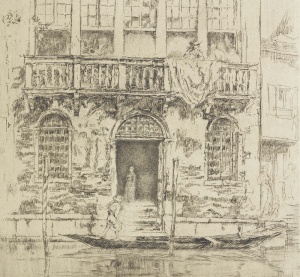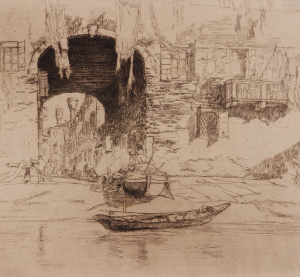
19th century Venice is brought to life in the artistic works of James McNeill Whistler. Applying a complex variety of patterns and strokes, his original prints reveal a city of days gone by whose haunting beauty is found in the everyday activities of its citizens.
James McNeill Whistler’s Peacock Room at the Freer Gallery of Art may be his most famous and lauded work, but his lesser-known prints of Venice have recently been put on display and represent a different facet of his artistic talent. The twenty-six prints were originally purchased in 1887 by Charles Lang Freer — the man whose donation created the Freer Gallery in the first place. It was this set of prints that ultimately prompted him to collect and preserve a vast array of Whistler’s work, which now resides at the Freer Gallery for public viewing.
Whistler was born in 1834 in Massachusetts, but most of his later life was spent in Britain. He began his career as an artist for the U.S. military, rendering maps of U.S. coastlines for the Navy. It was there that he was first exposed to the etching technique that he would eventually use to create his experimental Venice prints.
After completing his brief stint with the U.S. army, Whistler moved to Paris to study art. He gained footing in more traditional art methods and traveled extensively around Europe, creating artistic records of his adventures along the way. One such record, his set of Venice prints, now resides at the Freer Gallery.
The prints themselves are truly impressive. They were painstakingly created with etching and dry point, showing an acute awareness of minute details. What from a distance seems to be a series of indistinct squiggles, closer inspection reveals to be a network of carefully drawn etchings that bring the character of Venice to life. Long black ink slashes of the sky and water are intentionally contrasted with the more finely patterned scribbles of boats, architecture, and human figures, weaving together the complex beauty of the famous city.

Each print is equally haunting and alluring. Almost all of the people depicted either have their backs turned or do not have distinct facial features. The result is a picture of this beautiful, historically rich city full of people with blank stares. Other prints are haunting in their solitude, such as the lonely man standing in the darkness in the print “Nocturne: Furnace.”These elements evoke a balance between the perpetual and ephemeral nature of the experience of Venice. Every day brings with it a new set of faces that are there for a moment and vanish with the next, yet they are ever present in a city that continues to thrive. Whistler preserved this spirit in the deceptively simple texture of his scribbles. Detailed yet indistinct, the figures embody the ghostly presence of the ordinary people that have made Venice into the historical destination that it is today.
An especially poignant takeaway from the prints is the realization that this was everyday life for Venetians in the late 19th century. One print depicts a woman sitting outside her house in front of a canal as she prepares to sell fruit. Another shows a different group of women stringing beads and holding children nonchalantly. It’s striking that, while Venice seems something like a European Disneyland nowadays, it was a center of normal life for hundreds of years. The set of prints contains images ranging from panoramic views of the city to street views to views of the inside of homes, providing a comprehensive view of life in 19th century Venice.
If you’ve ever been to Venice, you might be inclined to agree that it has become very touristy and built-up in recent decades. Much of its original magic has been lost or replaced with fabrications. Whistler’s Venice prints give viewers the opportunity to glimpse what the Venice of our imaginations once looked like — a scene of winding, quiet canals, authentic gondolas and crumbling, ornate buildings that are wonderfully devoid of the McDonald’s signs that now seem to be present on every street corner.
While the prints themselves are reason enough to check out the exhibit, the story of how the prints came to reside at the Freer Gallery only adds to the display’s worth. When Freer first glimpsed Whistler’s work, he was not at all impressed. He did not understand “why anyone in the world should make any fuss over Whistler as an artist” and adamantly refused to show substantial interest.
However, after viewing more of Whistler’s remarkable work, Freer sheepishly admitted that he wanted to begin purchasing his pieces. Eventually, what began as a professional slight turned into a decades-long friendship between the two men. It’s accordingly poetic that the Freer Gallery now houses the largest collection of Whistler’s work.
Whether you’re in it for the story or the art itself, the Venice prints pull the viewer in with a cognizance of the underlying forces that built the character of such a well-known city. They provide both artistic dynamism and historical appeal with depths that do not fail to impress. The Venice prints at the Freer Gallery are definitely worth seeing, are cheaper than a trip to Venice and more authentic in their depiction of the city’s roots than the modern tourism that now permeates it.


















